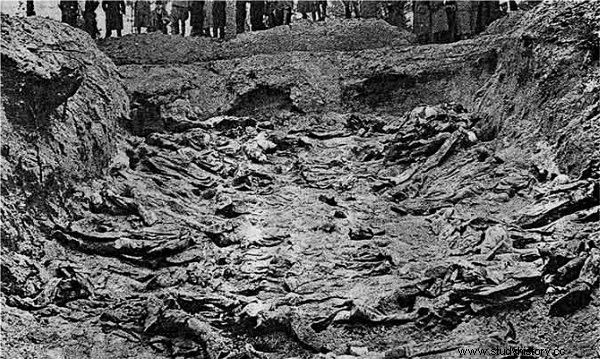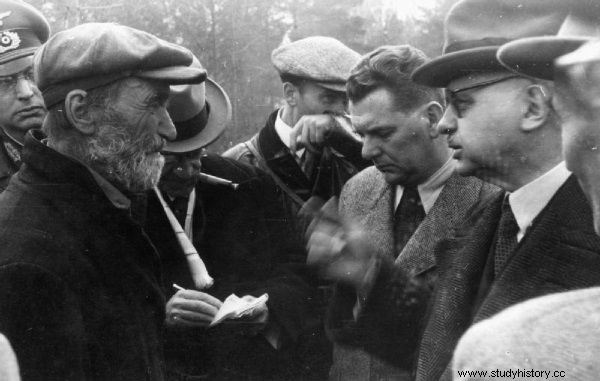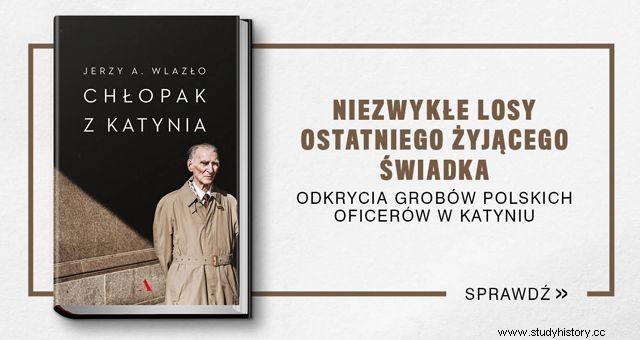Henryk Troszczyński was in a group of Poles who found traces of the Soviet crimes in the Katyn Forest. He was one of the first to know what fate befell the officers taken prisoner after the USSR's aggression against Poland in 1939.
At the beginning of July 1941, the Wehrmacht troops clashed with the Red Army near the town of Smolensk. The Germans hoped for an easy victory and a further swift march to the east, but the Red Army resisted effectively for a month. The town suffered a lot as a result of the war.
A group of forced laborers from the territories occupied by the Third Reich was sent to Smolensk. One of them was Henryk Troszczyński. He arrived by rail with 34 other Poles. They wore German coats, had forage caps on their heads, and white armbands with the inscription signifying forced laborers on their shoulders. They were hired to renovate the railway station, and then transferred to Katyn, to the Kozie Góra wilderness, to build barracks for German soldiers returning from the eastern front.
50 steps to the graves
In his memories, Troszczyński emphasizes the peace and quiet of the towns located near the front. Life, despite the fights lasting only 30 kilometers away, went on slowly in them. The workers' fate was not too bad either. They had one day of the week off. They could move freely around the area and contact its inhabitants. They also received a small salary, which allowed them to buy portions of Ruthenian dumplings or moonshine from nearby farms.

Henryk Troszczyński remembers the Katyn forest as dark and unfriendly. Above, a photo of the forest from 2013.
It was thanks to the talks with the locals that the Poles from Henryk's group found out that a crime had happened nearby. They indicated where to go to find the graves. This is how the moment of their discovery was described by Jerzy A. Wlazło in his book "Chłopak z Katyn":
At night they pick up their shovels and go to the indicated place. Highway. At the fifteenth kilometer from Smolensk, a small hill on the left. (…) They are walking exactly 50 steps. Heniek counts and will never forget. 50 big steps ...
The ground is still frozen, but they don't need to dig deep. It is enough to remove the top layer of the sheathing, the shovel to become tangled in the military coat .
At that time, the search for thousands of officers, interned after the USSR attack on Poland on September 17, 1939, continued in Poland. Some still hoped that the soldiers had been transferred deep into the Soviet Union. Thanks to his discovery and the stories of the locals, Henryk and his colleagues found out with their own eyes that this hope was in vain. The townspeople realized that the Katyn Forest was the final resting place of thousands of soldiers and did not want to keep it a secret.
Polish workers put up a small cross where the body was found. And Henry just then felt that he had to get out of there and try to come home.
In the footsteps of tragedy
The decision to liquidate the camps in Kozelsk, Starobielsk and Ostashkov, to which Polish soldiers were sent in 1939, was taken by the Politburo of the VKP (b) in early March 1940. The NKVD proceeded to carry out the order a month later.
According to Soviet documents, 4,404 prisoners were murdered and buried near Katyn. Those who had previously been held in the Kozelsk camp were sent there. The last account of Poles about these events are the notes of Major Adam Solski, found during the exhumation. These are the last sentences he wrote:
9 IV in the morning, a dozen or so minutes before 5 o'clock wake up in the prison cars and getting ready to leave. We have to drive the cars somewhere. What next?
On April 10th, the day started particularly well. Departure in a prison ambulance in cells (terrible). Brought somewhere in the woods, something like a summer resort. A detailed revision here. The watch on which it was 6.30 / 8.30 was taken, people asked about the wedding ring, rubles, main belt, pocket knife were taken.
There the notes fail.

One of the graves is exhumed in 1943.
The world found out by accident
Henryk told one of his German friends about his discovery. Contrary to his expectations, the information was not of interest to Wehrmacht officers. This only changed when the news reached Lieutenant Gregor Slovenzik. He was a propaganda clerk in the German command in Smolensk.
Seeing the possibility of using the information provided by Troszczyński for the benefit of the Third Reich, he passed it on to Berlin. Soon a propaganda campaign began at Goebbels' orders. Its goal was to divide the US and Great Britain with the USSR.
On April 13, 1943, Radio Berlin informed about the discovery of mass graves of Polish officers, murdered in the spring of 1940 by the Soviets. An International Medical Commission was also appointed, which arrived in Katyn on April 28 and started the exhumation works.

One of the residents tells the representatives of the International Commission about the events in the Katyn Forest
Henryk and other workers were on site when the work began. In their free time, they watched the work with horror, standing over the dug-out pits. This is how Jerzy A. Wlazło described it in his book "Chłopak z Katyn":
He saw how tables were set up in the open air, Russian workers discovering layers of bodies in Polish uniforms underground, and placing special platforms on piles in the ground above the bodies , building almost entire streets for wheelbarrows carrying dead bodies. He could see the hands tied behind his back, he could see the skull shot through from behind. (...) There was an unbearable, nauseating stench of decaying bodies around, and the mind did not assume the size of crime, cruelty, bestiality.
Ultimately, 4,443 Poles were exhumed in the Katyn Forest. Over 400 of them were not on the export list from the Kozelsk camp.
You can buy the book at empik.com: 
